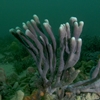General Description
A pale pink to white sponge species, thickly flabelliform. Size of about 50 cm.
Biology
Only two species of this genus group Fenestraspongia have been described to date, both of which are found in south-eastern Australia and only one of which has been recorded from Victorian waters.
Habitat
Reef areas, to depth of 30 m.
Sponge gardens
Reefs
Distribution guide
Port Phillip in Victoria.
Species Group
Depth
Water Column
Max Size
50 cm
Diet
Plankton or particles
Commercial Species
No
Global Dispersal
Native to Australia
Identify
Conservation Status
- DSE Advisory List : Not listed
- EPBC Act 1999 : Not listed
- IUCN Red List : Not listed





